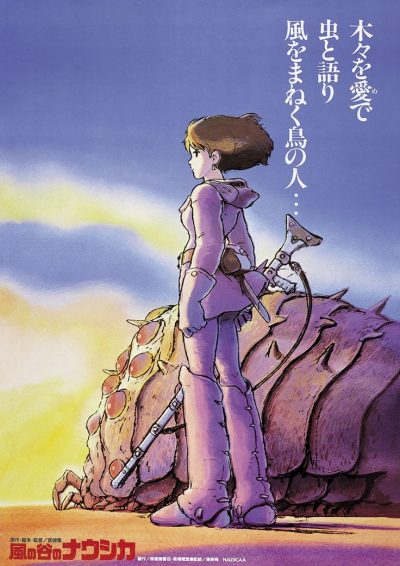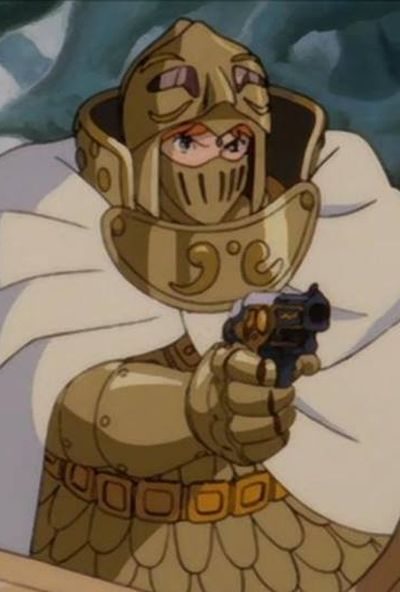★★★★½
“The wind rises.”

 After the enormous critical, if not commercial, success of Lupin III: Castle of Cagliostro, Miyazaki was commissioned to create a manga series for Animage magazine, with a potential film adaptation attached. Publication began in early 1982, but it would take a dozen years, albeit of intermittent publication, before that story was complete. When the series’s popularity among Animage readers was established, work began on the film adaptation, covering the early portion of the manga. Since this was before Miyazaki’s own Studio Ghibli was founded, an external company, Topcraft, were commissioned to create the animation. The budget was only $1 million, with a mere nine-month production schedule leading up to its release in March 1984.
After the enormous critical, if not commercial, success of Lupin III: Castle of Cagliostro, Miyazaki was commissioned to create a manga series for Animage magazine, with a potential film adaptation attached. Publication began in early 1982, but it would take a dozen years, albeit of intermittent publication, before that story was complete. When the series’s popularity among Animage readers was established, work began on the film adaptation, covering the early portion of the manga. Since this was before Miyazaki’s own Studio Ghibli was founded, an external company, Topcraft, were commissioned to create the animation. The budget was only $1 million, with a mere nine-month production schedule leading up to its release in March 1984.
It takes place on a post-apocalyptic world, a thousand years after the near-mythical “Seven Days of Fire”, pushed humanity to the edge of extinction. Since then, nature has taken over much of the planet, covering it in an expanding toxic jungle where the very air is poisonous in a few minutes. It is populated by equally lethal creatures, at the top being the “ohmu”, gigantic insectoids capable of destroying anything in its path. The human race is reduced to clinging on to the fringes, such as the small kingdom of the Valley of the Wind, in which a never-ending breeze keeps the toxins at bay. There, the king’s daughter, Nausicaä (Shimamoto), is one of the few brave enough to enter and explore the jungle, and has developed a mutually respectful relationship with its strange inhabitants.
The balance is destroyed when a plane from the kingdom of Tolmekia crashes. In its cargo is an enormous “God Warrior” – one of those which carried out the Seven Days of Fire – recently dug out from where it had been buried. Tolmekia and their rivals, Pejite, are wrestling for control of the warrior and the power it wields, and the crash drags the Valley of the Wind into their conflict. In particular, Princess Kushana of Tolmekia (Sakakibara) intends to use the warrior to destroy the jungle and restore mankind’s dominion over the planet. Nausicaä is ferociously opposed to this scheme, especially after discovering that the jungle is actually purifying the atmosphere and soil, absorbing the toxins from the apocalypse. She’ll do anything to stop Kushana, including being willing to sacrifice her own life if necessary.
There’s a lot going on here, as you can see. It’s somewhat understandable why, when initially shown in the West (one of the first examples of anime to receive a theatrical release), 22 minutes was cut out, in order to market it as a children’s film, retitled Warriors of the Wind. The problem is, like almost all of the director’s work, it is not a children’s film. This is not a uncommon mistake – presumably based on them having a child as the central characters, and because they’re animated, which still largely equates to Disney in many people’s minds. But they’re more about that age capturing an innocent and idealistic mentality. This is undeniably mature and thoughtful cinema. In just his second feature, and first original film, Nausicaä establishes several themes which would run through almost all of Miyazaki’s future work, in varying degrees: the joy of flight, concern for the environment, and a strong female presence.
 Miyazaki’s father ran an airplane parts company in World War II, and even his film company, Studio Ghibli, was named after an Italian plane. Almost every one of his movies includes a flying sequence, and Nausicaä certainly has plenty of them, whether its the heroine skimming across the desert on her one-person glider, or gigantic warships looming, threateningly, in the sky. Despite the imperfect animation, a result of the limited resources, the sense of wonder and awe is undeniable. If you don’t want to take to the skies after seeing these scenes, you might want to check for a pulse. Similarly, there’s no denying Miyazaki is firmly on the side of nature, with his heroine believing all life to be sacred, and humanity deserving no special place above any other species. If mankind can’t live in harmony with the world, the movie suggests, it’s mankind which needs to change. Bending nature to our will is always going to backfire.
Miyazaki’s father ran an airplane parts company in World War II, and even his film company, Studio Ghibli, was named after an Italian plane. Almost every one of his movies includes a flying sequence, and Nausicaä certainly has plenty of them, whether its the heroine skimming across the desert on her one-person glider, or gigantic warships looming, threateningly, in the sky. Despite the imperfect animation, a result of the limited resources, the sense of wonder and awe is undeniable. If you don’t want to take to the skies after seeing these scenes, you might want to check for a pulse. Similarly, there’s no denying Miyazaki is firmly on the side of nature, with his heroine believing all life to be sacred, and humanity deserving no special place above any other species. If mankind can’t live in harmony with the world, the movie suggests, it’s mankind which needs to change. Bending nature to our will is always going to backfire.
But it’s with the depiction of womankind that the film truly succeeds. In Nausicaä and Kushana, you have two fully-formed characters that are not just among the best in animated film, they could stand beside the protagonist and antagonist of most live-action movies. The latter, in particular, demonstrates Miyazaki’s skill at depicting those who would be flat-out villains in less nuanced films, instead being given motivation and depth. While you may not agree with Kushana resurrecting the God Warrior, you can understand what she is trying to accomplish. Her actions stem from a genuine belief that what she is doing is best for the future of mankind. She just has a military-industrial approach to that, in sharp contrast to the one emphasizing ecological science and harmony, preferred by Nausicaä. Interesting to note that, in the 2005 Disney English-language dub, Kushana was voiced by Uma Thurman.
The story here builds to a stellar climax, in which a massive herd of ohmu are lured into a stampede towards the valley, while simultaneously the God Warrior is unleashed by Kushana, to horrific effect. [The animation for the latter was done by a young Hideki Anno, who’d go on to become a master of the genre himself, best known for Neon Genesis Evangelion. In a 2006 Japanese poll, Evangelion was the only anime ranked ahead of Nausicaä as an all-time favourite] Our heroine puts herself in harm’s way in an effort to stop the carnage, and… Well, I won’t spoil it in detail; Miyazaki manages to pull off an ending which could easily have come off as contrived or ridiculous, and is instead emotionally satisfying. With even the Tolmekians forces humbled by nature, as environmental messages delivered by teenagers go, it’s certainly a great deal more effective than an angry Scandinavian shrieking “HOW DARE YOU!” at the audience.
Dir: Hayao Miyazaki
Star (voice): Sumi Shimamoto, Gorō Naya, Yōji Matsuda, Yoshiko Sakakibara




